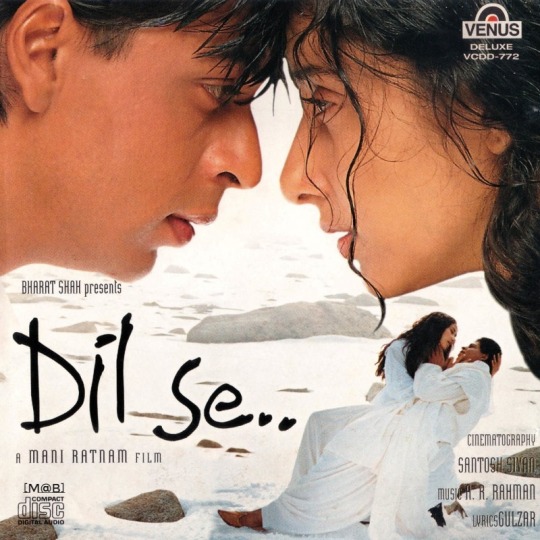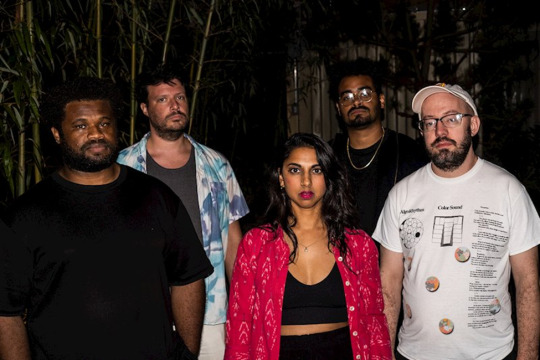#carnatic classical music
Explore tagged Tumblr posts
Text

Tracklist:
Chaiyya Chaiyya • Jiya Jale • Dil Se Re • Ae Ajnabi • Thayya Thayya • Satarangi Re
Spotify ♪ YouTube
#hyltta-polls#polls#artist: various artists#language: hindi#language: panjabi#language: malayalam#decade: 1990s#Filmi#Carnatic Classical Music#Indian Pop#Trip Hop#artist: A.R. Rahman#artist: Sukhwinder Singh#artist: Sapna Awasthi#artist: Lata Mangeshkar#artist: M.G. Sreekumar#artist: Anuradha#artist: Chandralekha Annupamaa#artist: Udit Narayan#artist: Mahalakshmi Iyer#artist: Sonu Nigam#artist: Kavita Krishnamurthy
9 notes
·
View notes
Text
Exploring the Intricacies of Indian Classical Music: A Journey Through Time and Tradition
Exploring the Intricacies of Indian Classical Music: A Journey Through Time and Tradition #IndianClassicalMusic #MusicTraditions #HindustaniMusic #CarnaticMusic #RaviShankar #BhimsenJoshi #MSSubbulakshmi #AllauddinKhan #MusicLandmarks #MusicalHeritage
Indian classical music is a rich tapestry of melodies, rhythms, and emotions that has evolved over thousands of years. Rooted in ancient scriptures and traditions, this musical form transcends boundaries and offers a window into the cultural heritage of India. In this extensive exploration, we delve into the nuances of Indian classical music, tracing its origins, understanding its structure, and…

View On WordPress
#Allauddin Khan#Bhimsen Joshi#Carnatic classical music#Hindustani classical music#Indian classical music#M. S. Subbulakshmi#music landmarks#music traditions#Musical Heritage#Ravi Shankar
0 notes
Text
Amirtha Kidambi's Elder Ones — New Monuments (We Jazz)

The great DC artist, audio scholar and activist Thomas Stanley once described Sun Ra’s concept of the Alter Destiny as “a small chunk of language, a key unlocking large powers and capacities that will allow us to realize sustainable futures that are not subordinate to the same imperial regime that fucked up our planet in the first place. History is the plantation, abolitionist Ra reminds us, and it is time to break loose from these chains and leave.” This is a particularly resonant message today, in an era of late capitalism, deteriorating institutions and genocidal warfare. Yet, the inevitable future promised to us by this seemingly unending quagmire presents a sense of stability in its repetition of failures that enables many of its subjects to cling to its promise even as we further careen into the abyss. Amirtha Kidambi is not one of those people, and in the five years since her previous release with her group Elder Ones — a period marked by the pandemic, the George Floyd protests, and a rapidly-encroaching American fascism — her resolve has only been strengthened. Their record New Monuments is a battle cry for building not a better future, but a different future entirely, one free from the ghosts of colonialism and imperialism.
Kidambi has a background in both new music and DIY, and navigating these disparate worlds has informed her unique approach to improvised music. This is on full display on the opening track “Third Space,” on which Kidambi sings with punk-inflected energy while maintaining complete control and authority over her vocals. The track takes its name from influential postcolonial theorist Homi K. Bhabha’s concept of a liminal space in which, in the context of colonial ambivalence, different cultures interact with each other. The (very) basic gist of this theory is that, in post-colonial society, culture is constantly moving, never one singular thing and never the property of any singular people. In turn, on this track, and the album as a whole, Kidambi defies any essentialized notion of “Indian music” or Indian jazz (which has become yet another needlessly limiting genre term in this “spiritual jazz” era), and not just by invoking Bhabha. From the moment the record kicks off, new agey world music treacle is left behind on another planet entirely.
On this record, Kidambi is backed by a top group of New York improvisers, including Elder Ones mainstay Matt Nelson on soprano saxophone alongside cellist Lester St. Louis, known for his work in the late Jaimie Branch’s Fly or Die group, and Jason Nazary, frequent collaborator of Darius Jones and one half of Jaimie Branch’s Anteloper group. Rounding out the quintet is Eva Lawitts, whose propulsive basswork pushes the multi-part compositions on the album forward. On album centerpiece “Farmer’s Day” the band balances a modal, in-the-pocket groove with loose improvisation, with a particularly dazzling solo from Nazary showing off his impressive and dynamic range as a percussionist. After this solo, the song slows to a crawl as Kidambi invokes the now-yearslong protest movement of Indian farmers against a series of bills designed to weaken working farmers and benefit corporations: “We work from cradle to grave / conditioned like a slave.” This is protest music, as clear in its radical intentions as it can be, but the Elder Ones find plenty of room for beauty in struggle. This is especially true on the title track, which has a synth line that, if isolated, would call to mind the devotional music Alice Coltrane recorded in the 80s. Kidambi asks “in the end is history always doomed to repeat?” The answer she arrives at for this unanswerable question is to “build new monuments to new futures,” an affirmation of the Alter Destiny. Though the struggle is neverending, these new futures are still well within our capabilities. All it takes is a level of fearlessness, something Amirtha Kidambi has shown in spades on this record.
by Levi Dayan
#amirtha kidambi's elder ones#new monuments#we jazz#levi dayan#albumreview#dusted magazine#jazz#Carnatic classical music#harmonium#Matt Nelson#Lester St. Louis#Jason Nazary#Eva Lawitts#free jazz#avant garde jazz#vocal jazz
0 notes
Text
youtube
Rara venu Gopabala is a beautiful song set in Bilahari Raagam. It is a wonderful and simple melody. The lyrics praise Lord Krishna, his wonderful qualities and request him to come to our world and spread cheer. This is my first recording with my Son Arjun! I have mixed some electronic beats and a warm synth pad to keep the song contemporary. Hope you like our rendition of this wonderful song. Watch this beautiful video, Rara Venu Gopabala Carnatic Fusion By Arjun Mohan and Karthik Mohan.
#indian classical singer#famous classical songs#carnatic music vocal#carnatic classical music#south indian classical music#indian song#Youtube
0 notes
Text
Hiii my slaysss💅 (why do I start my posts like this jdkdjfkdkd)
Here I am after a weeklong hiatus- TvT✨
Had quite a long day and wanted to sleep so bad, andddd now I'm not able to sleep🙂 I-
Sooo here's me doing an improv. segment on my Veena (Aalapanai and Taanam) in the Ragam Arabhi!
The scale reminds me of these really pretty yellow flowers called Konrai Malar back home!
Hopefully this puts me to sleep! Until later! Take care y'all!♥️🌼
#carnatic music#Carnatic#Saraswati Veena#Arabhi#Ragam#Taanam#Aalapanai#musicblr#music#i need sleep#indian classical music#spring colors#floral
2 notes
·
View notes
Text
TalaGroove
Metronome, Carnatic Video lessons, polyRhythm

2 notes
·
View notes
Text
Udupi Hindu Ancient Musical Melody
#udupi#udupi krishna#indian classical music#indian music#world music#indian carnatic music#hinduism#hindu mythology#krishna#hare krishna#iskcon#sanatandharma#rama#hindusim#ramayana#hindu
5 notes
·
View notes
Text
youtube
newest addition to the ever expanding hot brown girl summer mix
#she's vaguely gay as well but also we're around the same age and were in the same artistic classical circles at one point and i keep like#does she fr look familiar to me or am i making it up. is my brain playing tricks on me or do i know ur carnatic guru#anyway the song GOES#music#Youtube
7 notes
·
View notes
Video
youtube
Ramakatha Sudha - Madhyamavathi - Adi

0 notes
Text
From Celtic to Carnatic: A Fascinating Look at Traditional Music Styles
Introduction: Music has always been a universal language that transcends borders and connects people from different cultures around the world. From the haunting melodies of Celtic music to the complex rhythms of Carnatic music, traditional music styles offer a glimpse into the rich cultural heritage of different regions. In this article, we will explore the unique characteristics of Celtic and…
#Carnatic#Celtic#Contemporary art trends#cultural heritage sites#digital art techniques#evolution of dance styles#famous art museums#Fascinating#history of modern art#how to appreciate classical music.#impact of art on society#influential artists of the 21st century#music#popular cultural festivals#significance of folklore in culture#street art and graffiti#Styles#Traditional#traditional cultural practices#traditional music from around the world#understanding abstract art
0 notes
Text
Top Indian Classical Music Classes | Sri Vageeshwari
At SVSM, delve into the nuances of Indian classical music with customized lessons personal style, and pace of learning—more at https://srivageeshwari.com.
0 notes
Text

The Carnatic Way: https://podcasters.spotify.com/pod/show/author-vram/episodes/The-Carnatic-Way----With-Ramaa-Ramesh-e2nj8ge
0 notes
Text
youtube
Carnatic fusion, highly recommend
0 notes
Text
youtube
Sanware Tore Bina | Bandit Queen | Raag Jog | Covered by Karthik Mohan
Sanware Tore Bina is a song from the Movie Bandit Queen, set in Raag Jog, it is about a heart that yearns to be with the loved one. Raag Jog has similarities with Naatai raga in Carnatic music. Where Naatai is used in devotional and up beat songs, Raag Jog's notations have a more melancholic vibe. Original Song: Sanware Tore Bina Music Director:Nusrat Fatheh Ali Khan Movie: Bandit Queen
#movie bandit queen#nusrat fatheh ali khan#hindustaniclassicalmusic#indianclassicalmusic#tablaplayer#bollywood movies#hindi movie#hindustanimusic#sanware tore bina#kaushiki chakraborty#hindustani classical music#nusrat fateh ali khan qawwali#karthik mohan#covered by karthik mohan#raag jog#carnatic music#devotional songs#indianclassical#tanpura#instrumental music#independent artist#music producer#north of India#contemporary Indian music#hindi songs#Youtube
1 note
·
View note
Text

Helen DeWitt, The Last Samurai
"The musical scale is a convention which circumscribes the area of potentiality and permits construction within those limits in its own particular symmetry."
Iannis Xenakis
#not meant to derail the initial point.. which as someone who has studied western and carnatic classical music: yeah.#but thought i'd include a passage from a book that also thinks about the limitations of western theory (musical and otherwise)#though it does not take the step to consider other musical traditions
240 notes
·
View notes
Text
Raga Musics is an eclectic music business that specializes in traditional Indian ragas. For a unique and authentic experience, come and enjoy the melodic sounds of ragas, expertly performed by our talented musicians.. Our mission is to create a community of music lovers and to provide a platform for artists to showcase their talents and reach a wider audience
1 note
·
View note